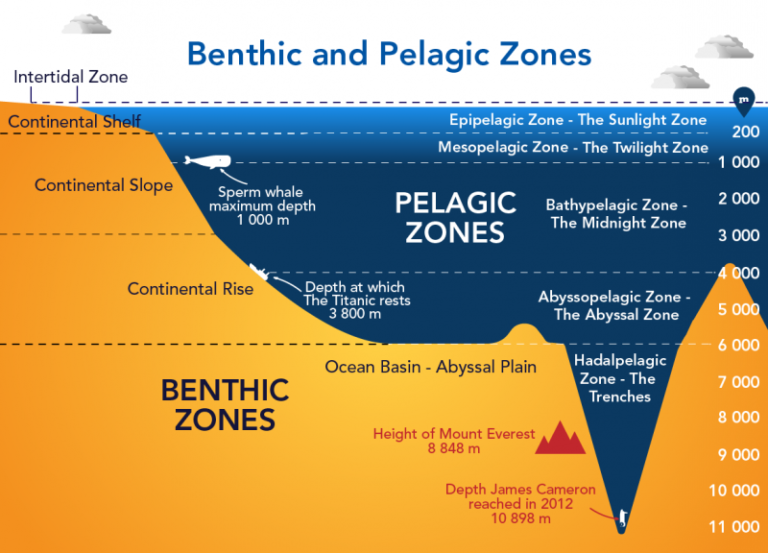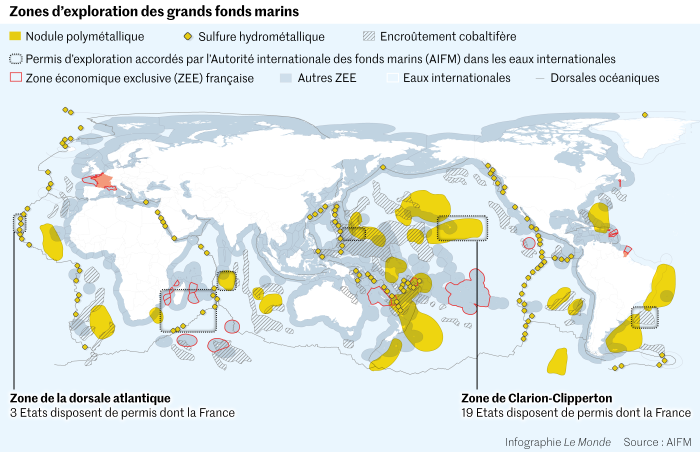The international community is focused on the deep sea to meet the ecological challenges and human demands. There is a growing interest in this vast and still poorly explored area, where only 10% of living species have been recorded. France is at the forefront of this exploratory field, with potential still undefined in many fields. Science, marine energy, biodiversity and health all take inspiration from different environments, but what about the deep seabed ? What is the potential of the deep sea for humanity ? What can be found more than 1,000 metres underwater ? Who are the players in this new market ?
What is the deep sea ?

The depth of the oceans is classified into 5 distinct submarine zones, 3 of which are defined as deep-sea zones. The epipelagic zone, 0-200 m deep, lies on the continental shelf. The mesopelagic zone, home to a million recorded marine species, lies between 200-1000 m.
The bathypelagic zone is still a shadow area today. It covers a depth of between 1,000 and 4,000 metres and is the starting point for the deep ocean, along with 2 other zones: the abyssopelagic zone (> 4,000 metres) and the hadal zone (> 6,000 metres). These deep seas represent 88.1% of the ocean floor, or more than 320 million square kilometres that have yet to be explored, according to the Fondation de la mer (Fondation de la Mer, 2022).
Defined as being 1000 m underwater, the deep sea is a place where there is a total absence of light, extreme cold and high pressure. More usually described as the abyss, the deep sea occupies two-thirds of planet Earth. The deep sea has unique characteristics. They have a cold, stable temperature, extreme pressure, total darkness, bioluminescence, vast expanses of flat seabed and low levels of dissolved oxygen. It’s an environment like no other on planet Earth, making it a still unknown territory.
A potential reserve of biological and mineral wealth
Sometimes considered to be the cradle of life, the deep seabed is potentially an extremely rich biological and mining reserve. The economic, ecological and environmental issues involved are significant.
In complete opposition with photosynthesis, which was then perceived as the motor of life, a discovery made in 1977 called into question the assumption that there was an inert zone where photosynthesis could not be present. The discovery of microbacterial chemosynthesis demonstrated that abyssal species develop thanks to the chemical energy released by hydrothermal vents (Sarradin et al., 2017). A fauna with complex characteristics, a source of potential solutions for science. Scientist Kerry Hawell supports the idea of a radiant future, with considerable potential for science and health. The new molecules could be the source of an revolution in antibiotic treatment, which has not evolved for more than 30 years, creating a massive addiction. The number of deaths from drug resistance could reach ten million people a year by 2050. Marine sponges possess an antibiotic reservoir of as yet unknown bacterial origin, which could become the new strain of tomorrow’s drugs (Howell, 2021b).
A large variety of living organisms are inspiring thinking on an industrial dimension. The halmonas titanica, for example, metabolises iron and represents an interesting avenue of research into the degradation and management of shipwrecks that have fallen to the bottom of the ocean. These as yet unknown marine species represent 90% of the species present on the ocean floor.
These mineral resources are located in 3 potential environments that have already been identified :
► Polymetallic nodules are found in the abyssal plains (at depths of between 4,000 and 6,000 metres). They are rich in rare metals, including manganese, copper, nickel and cobalt.
► Cobalt crusts are massive deposits that can reach a layer of 25 cm. These deposits, rich in iron and manganese oxides, are thought to be the result of a chemical reaction. There is 3 times more cobalt than in the other identified sources, which makes it a special name: cobalt crusts.
► Hydrothermal vents, also known as black smokers, are the result of marine water heated to several thousand degrees through rock fissures in the direct proximity of the magma chamber. As this water drains away, it releases mainly iron sulphide, base metals (copper, zinc, lead) and precious metals (silver and gold).
These seabed resources are generally composed of earths and rare metals (cobalt, lithium and nickel). Onshore reserves of these various metals, particularly cobalt, are considered critical by the European Union. Their availability in large quantities and the fact that they do not require massive and polluting extraction, unlike terrestrial extraction, make them a coveted potential source. These rare earths and metals also play a part in the world of tomorrow and are essential for speeding up the energy transition. New green energies need rare metals for their construction. In 2023, it is estimated that seventeen kilos of rare earths will be needed to build a wind turbine.
These areas are still largely unexplored

Bathymetric measurements provide a better understanding of the depths of the ocean. These scientific maps also reveal areas of strategic interest. The world’s oceans continue to be unexplored territory beyond a depth of 1,000 metres. The IAMF, based in Jamaica, is the regulatory authority for deep-sea exploration. To date (July 2023), it has granted 31 exploration licences, 19 of which are in the Clarion-Clipperton zone.
This zone is particularly defined, as it is identified as one of the 5 lines of the North Pacific floor. Otherwise known as the ocean bill, it is around 7,240 km long and covers some 4,500,000 square kilometres. A source of life and wealth coveted by many international players, including France, which has a licence until 2026.
The singular position of France
France has the largest deep-water exclusive economic zone in the world. More than 10 million square kilometres are located below a depth of 1,000 metres, or 93% of the total surface area of the French seabed. Second place goes to the United States EEZ. France therefore has a major responsibility towards future generations.
France has launched its “Grands Fonds Marins” plan as part of its France 2030 strategy. The plan is designed to map, monitor, explore and investigate the French seabed. This initiative is part of an overall approach designed to meet the operational needs of maritime governance and, more generally, to contribute to operational oceanography. This call for deep-sea projects aims to support the emergence of innovative solutions, with a budget of €25 million.
The French government and Mercator-Ocean (Spain, Italy, Norway, Portugal, the United Kingdom and France) are also working together to create a digital twin of the ocean. Seabed2023 is a large-scale project to “design the most effective ways to restore and protect marine and coastal habitats, support sustainable markets for the blue economy, and mitigate and adapt to climate change” (Digital Twin of the Ocean – Mercator Ocean – Ocean Forecasters, 2023).
Challenges and new technologies
“We know less about the seabed than we do about the surface of the Moon and Mars. (5)(Mapping the Gaps in Our Ocean Knowledge with Seabed 2030, n. d.). In 2023, the deep ocean will be a new challenge for the international community. In 2023, only five people (Jacques Piccard, Don Walsh, James Cameron, Victor Vescovo and Kathryn Sullivan) will have plumbed to the heart of the Marianne Trench at 10,971 metres (the deepest place in the ocean). The moon currently has 12 visitors.
France has the material and human resources needed to explore these deep waters. Its French oceanographic fleet, including ifremer’s manned submarine Nautile, explores waters to a maximum depth of -6034 metres. Robots and AUVs are also part of the ultra-sophisticated equipment used for oceanographic exploration. However, there are still technical constraints. The opacity of the water, the pressure 1,000 times greater than that of the atmosphere, and the lack of precise mapping are all obstacles to these explorations. The energy required to operate existing solutions also limits the efficiency of some equipment. These solutions reduce exploration times and consume large quantities of battery power. These solutions are the focus of a constant R&D effort.
Many companies are working to remove the technical obstacles and open the doors to this mystery world. The means of exploration, such as remotely operated vehicles able to travel at depths of over 3,000 metres, are extremely limited. What’s more, they have to be deployed from a surface vessel with which they maintain a cable link for power and control, limiting missions in time and space.
One solution under study would be to set up permanent autonomous stations for power supply and communication at great depths. These stations, connected by a dynamic cable to a surface buoy capable of both producing energy and communicating with land, could serve as a starting point for the long-term deployment of autonomous instruments and vehicles without a support vessel. GEPS Techno and its partner Acergy France are currently working on this new concept. The first tests of such a station could take place as early as 2025 in a trench in the Mediterranean.
Sources
► Rapport : Fondation de la Mer – Les grands fonds marins | 2022
► Sarradin, P., Sarrazin, J. & Lallier, F. (2017). Les impacts environnementaux de l’exploitation minière des fonds marins : un état des lieux des connaissances. Annales des Mines – Responsabilité et environnement, 85, 30-34. https://doi.org/10.3917/re1.085.0030
► Howell, K. (2021c). Deep-sea Discovery – Mining marine environments for novel biologics. https://pearl.plymouth.ac.uk/handle/10026.1/18455
► Digital Twin of the Ocean – Mercator Océan – Ocean Forecasters. (2023, 21 juin). Mercator Océan – Ocean Forecasters. https://www.mercator-ocean.eu/digital-twin-ocean/
► Mapping the gaps in our ocean knowledge with Seabed 2030. (s. d.). https://oceanservice.noaa.gov/news/jun22/seabed-2030.html

